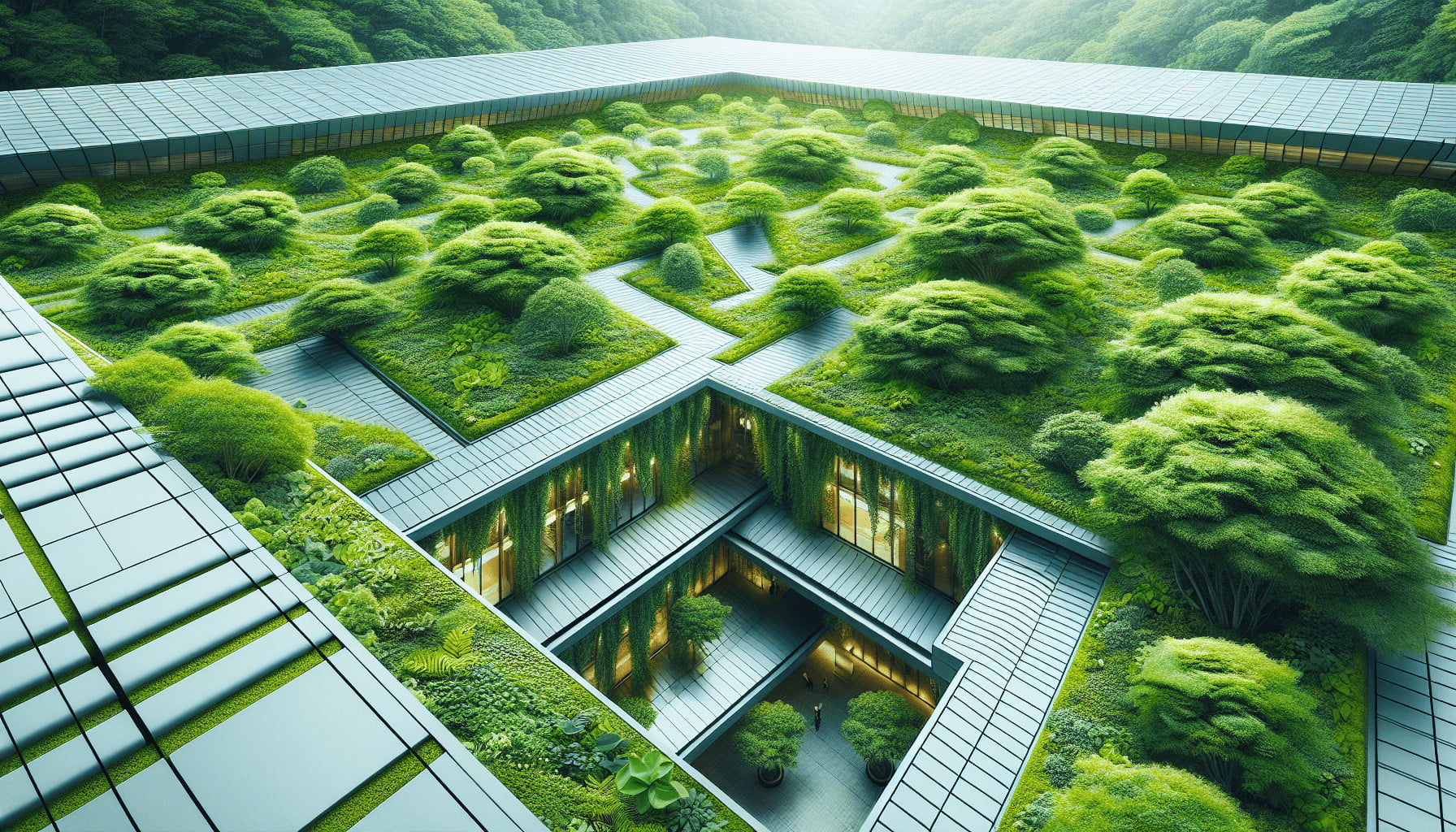In “The Importance of Proper Waterproofing in Green Roof Installation,” you’ll discover why taking the time to correctly waterproof your green roof can save you from a litany of headaches down the line. Whether you’re looking to boost your building’s energy efficiency, add an eco-friendly touch, or simply enjoy a lush garden atop your home, proper waterproofing ensures that you avoid moisture-related issues such as leaks and structural damage.
Have you ever considered why waterproofing is crucial in the installation of green roofs? If not, it’s time to dive deep into the topic. Whether you’re an architect, a builder, or just someone interested in sustainable building practices, understanding the importance of proper waterproofing can save you a lot of headaches down the line.

Introduction to Green Roofs
Green roofs, also known as vegetative or living roofs, are becoming increasingly popular, and for good reason. They offer a slew of benefits, from enhancing the aesthetic appeal of buildings to improving air quality and reducing the urban heat island effect. However, one of the fundamental aspects that can make or break the success of a green roof is proper waterproofing.
Why Waterproofing is Essential
Protects Structural Integrity
The foremost reason for waterproofing your green roof is to protect the structural integrity of the building. Water infiltration can be disastrous, leading to rotting materials, mold growth, and even compromising the building’s foundational elements. Proper waterproofing ensures that water stays where it belongs—outside your building.
Extends Roof Lifespan
Waterproofing materials act as a barrier, protecting your roof from wear and tear caused by water. This not only extends the lifespan of the roof itself but also minimizes maintenance needs, saving you money and effort in the long run.
Prevents Mold and Mildew
Unchecked water can lead to the growth of mold and mildew, which is not only unsightly but can also pose serious health risks. A properly waterproofed green roof ensures that moisture doesn’t seep into unwanted places, thus keeping your environment healthy and mold-free.
Components of a Green Roof
Before diving into the intricacies of waterproofing, it’s essential to understand the components that make up a green roof.
| Component | Function |
|---|---|
| Vegetative Layer | Provides aesthetic appeal and functional benefits like insulation. |
| Growing Medium | Serves as the soil substitute for plant growth. |
| Drainage Layer | Allows excess water to escape, preventing waterlogging. |
| Root Barrier | Prevents roots from penetrating the waterproof membrane. |
| Insulation Layer | Enhances thermal performance of the building. |
| Waterproof Membrane | The key layer that prevents water from seeping into the building. |
Vegetative Layer
This is the topmost layer consisting of plants. The choice of plants will depend on various factors such as climate, roof structure, and aesthetic preferences.
Growing Medium
A specially formulated soil substitute, the growing medium is designed to support plant life while being lightweight enough to not compromise the structural integrity of the building.
Drainage Layer
An effective drainage system ensures that excess water is quickly evacuated, thereby preventing waterlogging and ensuring the health of the vegetative layer.
Root Barrier
This layer prevents the plant roots from penetrating deeper into the roof, safeguarding the waterproof membrane.
Insulation Layer
Enhancing the thermal performance of the building, the insulation layer plays a crucial role in energy efficiency.
Waterproof Membrane
Arguably the most critical component, the waterproof membrane ensures that water doesn’t enter the building structure.
Types of Waterproofing Membranes
Liquid-Applied Membranes
Liquid-applied membranes are popular due to their seamless application. They are versatile and can adapt to the various contours and angles of a roof. When applied correctly, they provide a highly durable and effective waterproof barrier.
Sheet Membranes
Sheet membranes, often made from materials like TPO (Thermoplastic Polyolefin) or EPDM (Ethylene Propylene Diene Monomer), are rolled out onto the roof surface. These are highly durable and reliable but may involve more complex installation procedures compared to liquid-applied options.
| Waterproofing Membrane | Pros | Cons |
|---|---|---|
| Liquid-Applied | Seamless and adaptable | Requires skilled application |
| Sheet Membranes | Highly durable and reliable | May involve complex installation |
Spray Polyurethane Foam (SPF)
SPF acts as both an insulator and a waterproofing membrane. When sprayed onto the roof surface, it expands to form a continuous layer that is both waterproof and thermally insulating.
Self-Adhering Membranes
Self-adhering membranes come with an adhesive layer that allows them to be easily applied to the roof surface. This method is often less labor-intensive and reduces installation time.

The Waterproofing Installation Process
Surface Preparation
Before any waterproofing membrane can be applied, the roof surface must be thoroughly cleaned and prepared. This involves removing any debris, dust, and contaminants that could impede the adhesion of the membrane.
Primer Application
For certain types of membranes, a primer may be necessary to ensure that the waterproof layer adheres properly to the roof surface. This step is crucial as it enhances the adhesion and longevity of the waterproofing layer.
Membrane Application
Depending on the type of membrane being used, the application process will vary:
- Liquid-Applied Membranes: These are generally applied using a roller, brush, or spray system.
- Sheet Membranes: Rolled out and adhered to the roof surface, often involving heat-welding or adhesive application.
- Spray Polyurethane Foam: Sprayed onto the surface, expanding to form a continuous waterproof layer.
- Self-Adhering Membranes: Rolled out and pressed onto the prepared surface.
Sealing and Inspection
After application, it’s imperative to seal all edges and seams and then inspect the entire waterproofing membrane for any gaps or defects. Proper sealing ensures that there are no weak points where water can penetrate.
Common Mistakes in Waterproofing
Inadequate Surface Preparation
One of the most common mistakes is not adequately preparing the roof surface. Any debris or dust can compromise the adhesion of the waterproof membrane, leading to potential leaks.
Skipping the Primer
While some may consider primer application an optional step, it is critical for ensuring that the membrane adheres securely to the roof surface.
Poor Application Techniques
Improper application can result in uneven coverage and missed spots. It’s essential to follow the manufacturer’s guidelines closely and employ skilled technicians for the job.
Inadequate Sealing
Finally, failing to adequately seal all edges, seams, and penetrations can render the waterproofing ineffective.
Long-Term Maintenance and Inspection
Regular Inspections
Routine inspections are key to maintaining the performance of your green roof’s waterproofing system. Look for signs of wear and tear, such as cracks, blisters, or areas where the membrane is separating from the roof surface.
Prompt Repairs
If any issues are identified during inspections, prompt repairs are crucial. Even minor defects can lead to significant water infiltration if left unattended.
Cleaning and Debris Removal
Keep the roof surface clean and free from debris that could damage the waterproof membrane. Ensure that drainage systems are clear to prevent water pooling and potential leaks.
The Role of Professional Installation
While it might be tempting to tackle waterproofing as a DIY project, it’s generally advisable to hire professionals. Experienced contractors have the know-how and skills to ensure that the membrane is applied correctly and efficiently.
Choosing the Right Contractor
When selecting a contractor for your green roof installation, consider the following:
- Experience: Make sure the contractor has extensive experience with green roofs and waterproofing.
- References: Ask for references and check reviews to ensure they have a strong track record.
- Certifications: Verify that the contractor has the necessary certifications and complies with local building codes.
| Consideration | Why It Matters |
|---|---|
| Experience | Ensures expertise in dealing with green roofs and waterproofing. |
| References | Provides assurance of their reliability and past performance. |
| Certifications | Confirms the contractor meets industry standards. |
Innovations in Waterproofing Technologies
Advanced Membrane Materials
The world of waterproofing is continually evolving, with new, more advanced materials being developed. These innovations often offer enhanced durability, flexibility, and ease of installation.
Smart Roof Technologies
Some modern green roofs now incorporate smart technologies that can monitor the health of the waterproof membrane, alerting you to potential issues before they escalate into significant problems.
Eco-Friendly Solutions
As sustainability becomes a paramount concern, manufacturers are developing eco-friendly waterproofing solutions that align with the broader goals of green roofing.
Conclusion
To sum it all up, proper waterproofing is an indispensable element in the installation of green roofs. It safeguards the structural integrity of your building, extends the lifespan of the roofing system, and prevents the growth of mold and mildew. By understanding the components, knowing the types of waterproofing membranes, following the right installation processes, avoiding common mistakes, and ensuring long-term maintenance, you can ensure the success of your green roof project.
Remember, while DIY projects can be fun and rewarding, the complexities and importance of proper waterproofing often necessitate professional intervention. So, take the time to hire experienced contractors and benefit from the latest innovations in waterproofing technology. Your green roof will not only be a beautiful and environmentally friendly asset but also a durable and long-lasting one.
By putting the right measures in place, you’ll enjoy all the perks that green roofs offer, without the worry of water damage. Happy green roofing!
